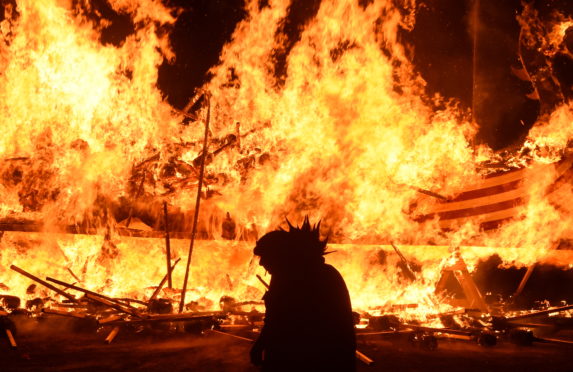Up Helly Aa – whit a lock o hellery!
Press and Journal readers will have enjoyed the last few days’ coverage of Shetland’s gift to the world’s intangible cultural heritage and to Viking enthusiasts everywhere. It’s Europe’s greatest fire festival and has been brightening up ‘the auld grey toon’ of Lerwick since the 19th century.
For anyone who’s only ever witnessed the spectacle through these pages, a visit should be stuffed into the bucket list bucket. It’s even worth braving the North Sea at its winter worst for. The relief of having survived with your life, if not your dinner, will only add to your desire to celebrate, thanking the old Norse gods, who seem to preside over this occasion, for getting you here in one piece.
This year, like every year, I had a snigger at the satirical bill, posted up in the town and which takes no prisoners. I watched the spectacular procession, gawped at the guizers’ costumes – all males, gasped at the burning torches being thrown into the galley and felt a lump in the throat when the crowd sang ‘The Norseman’s Home’. That home ‘in days gone by, was on the rolling sea…the noble, hardy, northern men, who ruled the stormy wave’ – which is odd as I come from Stirling!
After the ritual galley burning, while trying not to fall over the equipment of the world’s film crews, the crowd dispersed in time-honoured tradition to halls around Lerwick for a night of misrule, or dancing, drinking and fun. Each of the squads that has been involved in the procession, then progressed around the various halls where they performed a song or skit for the entertainment of those therein. By the end of the night their performances had reached a peak of perfection, or perhaps not.
Is Up Helly Aa authentic? Of course it is. It’s a community festival that has grown organically over the years and has developed its own traditions, foibles and ways of doing things. Is it an authentic Viking festival? Well, it has its origins in the Victorian era, so it does not date back to the time when Ragnar Hairy-Breeks was daring snake pits, but who cares. It has its Viking theme, and Vikings have been an integral part of the Shetland scene since the 19th century, when local intellectuals like J. J. Haldane Burgess who wrote the Up Helly Aa song, were busy creating a Norse Shetland identity distinct from that of Scotland. Nothing expresses the Shetland character more than the horned helmets of the Jarl’s squad.
Mea culpa, I have not personally taken part in Lerwick’s Mardi Gras. However, local Up Helly Aas take place throughout Shetland from early January to March, and I enjoyed being in the Scalloway Jarl’s squad in 2013. Scalloway is the ancient capital of Shetland and was a place of note when Lerwick was a den of iniquity frequented by Dutchmen. The Scalloway Fire Festival is rightly the first of the season taking place on the second Friday in January. Being considered something of a Viking mythology geek, not something unusual in Shetland, I had the task of helping the Scalloway Jarl decide on his Viking identity. Every Jarl adopts a name from Old Norse tradition.
I suggested the character of Böðvar Bjarki, the son of the were-bear Björn, the son of King Hring of Uppland in Norway. Björn had been enchanted by his own step-mother, the evil finnwife and galdragon, Queen Hvit, whose amorous advances he rejected. Every dawn he turned into a ferocious bear, killing cattle and terrorizing the surrounding lands. Luckily our Jarl was not quite as fierce as his namesake. In fact, with our pink helmets we were not the most terrifying of Viking warriors. However, this year’s Lerwick Guizer Jarl Liam Summers, who is the 100th Jarl, as befits this amazing milestone, took on the role of the terrifying Norse god Odin, Lord of the Gallows.
Oh yes, I almost forgot, ‘A lock o hellery’ means a lot of nonsense and although I have heard one or two disgruntled natives or gender warriors voicing this sentiment, in fact you will find very few in Shetland expressing this view. Most Shetlanders look forward to Up Helly Aa and will endure wind, hail and sleet to watch the galley pyrotechnics, before heading off for a night of fun, dancing and perhaps even a drink or two. If you want to experience it for yourself, you’ll be welcome next year, but if you are too chicken to brave the cold North Sea, or your Viking blood is thin, then you will be able to watch the live webcast on the Promote Shetland website.
Dr Andrew Jennings is the Programme Leader for the University of the Highlands and Islands Institute for Northern Studies masters programmes, including viking studies, island studies and Orkney and Shetland studies. He is based at Shetland College UHI.

